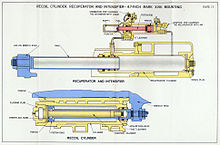| This article includes a list of references, related reading, or external links, but its sources remain unclear because it lacks inline citations. Please help improve this article by introducing more precise citations. (May 2024) (Learn how and when to remove this message) |

A hydraulic recoil mechanism is a way of limiting the effects of recoil and adding to the accuracy and firepower of an artillery piece.
Description

The idea of using a water brake to counteract the recoil of naval cannons was first suggested to the British Admiralty by Carl Wilhelm Siemens in early 1870s, but it took about a decade for other people (primarily Josiah Vavasseur) to commercialize the idea.
The usual recoil system in modern quick-firing guns is the hydro-pneumatic recoil system. In this system, the barrel is mounted on rails on which it can recoil to the rear, and the recoil is taken up by a cylinder which is similar in operation to an automotive gas-charged shock absorber, and is commonly visible as a cylinder mounted parallel to the barrel of the gun, but shorter and smaller than it. The cylinder contains a charge of compressed air, as well as hydraulic oil; in operation, the barrel's energy is taken up in compressing the air as the barrel recoils backward, then is dissipated via hydraulic damping as the barrel returns forward to the firing position. The recoil impulse is thus spread out over the time in which the barrel is compressing the air, rather than over the much narrower interval of time when the projectile is being fired. This greatly reduces the peak force conveyed to the mount (or to the ground on which the gun has been emplaced).
See also
- Canon de 75 modèle 1897, the first field gun employing a hydro-pneumatic recoil mechanism
- List of British ordnance terms
External links
- A "cutaway" animation of the Canon de 75 modèle 1897 showing the parts and operation of its revolutionary recoil mechanism
References
- Britain), Institution of Mechanical Engineers (Great (1886). Proceedings of the Institution of Mechanical Engineers.
You can help expand this article with text translated from the corresponding article in German. Click for important translation instructions.
|
This article related to weaponry is a stub. You can help Misplaced Pages by expanding it. |